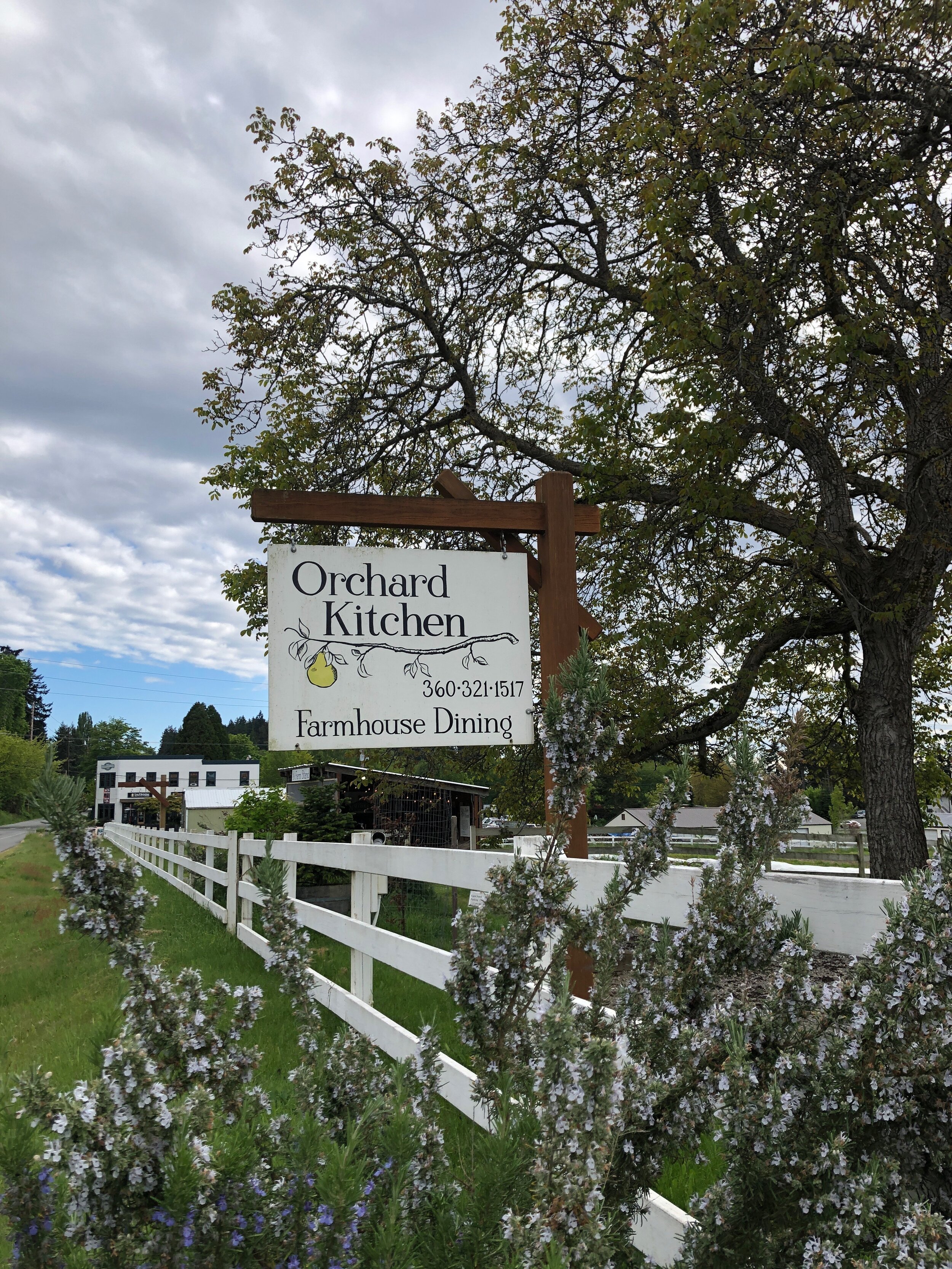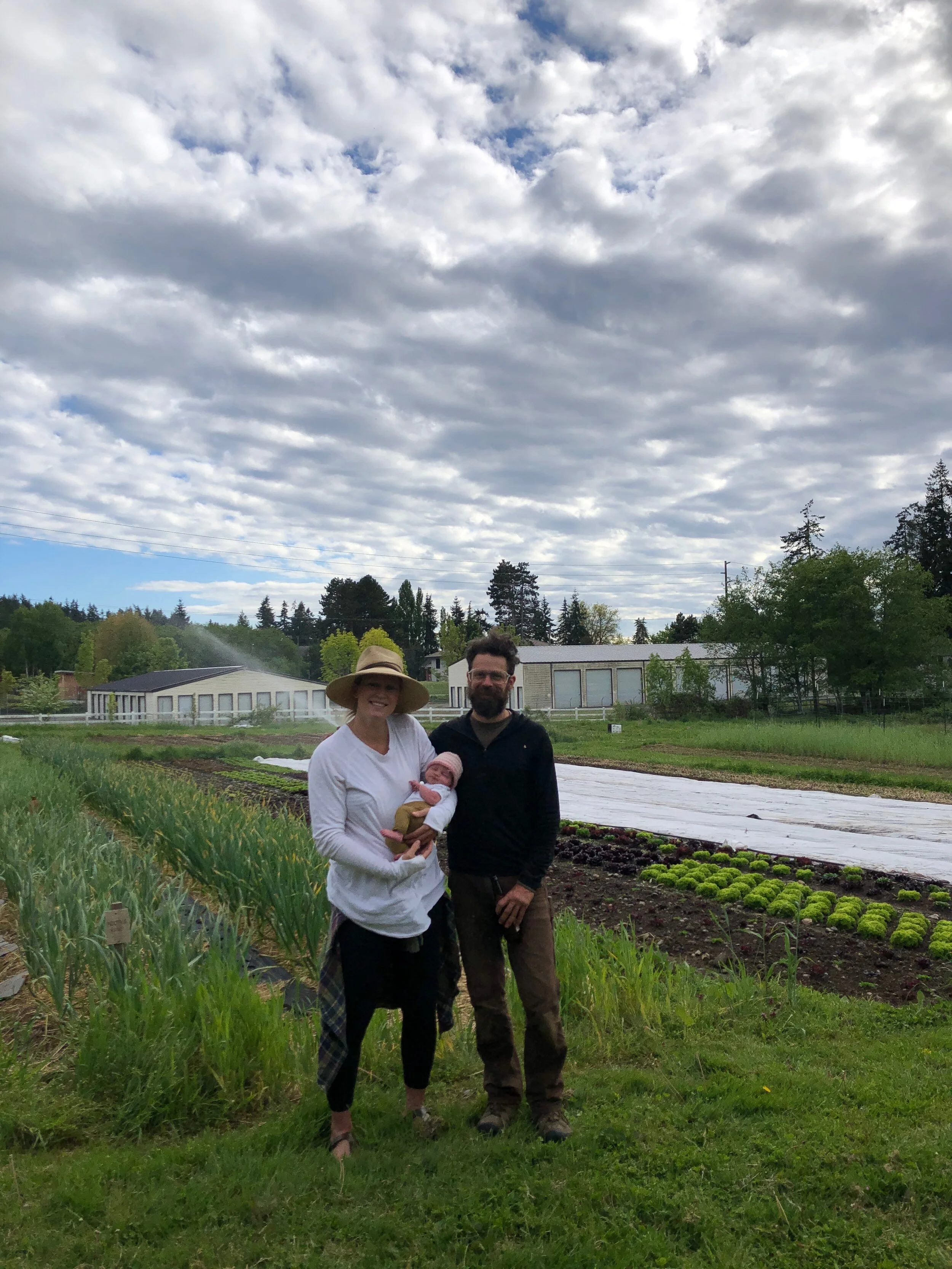Orchard Farm
After leaving an eight year corporate career in the health and fitness industry, Savannah took a leap of faith with the intention of contributing to the world in a more meaningful way. In 2017, she moved to Whidbey Island to attend the Organic Farm School, and shortly after graduating, she began farming for the Orchard Kitchen. Ever since then, she’s been working closely with Vincent Nattress, Orchard Kitchen’s chef and co-owner, to grow all sorts of organic crops that he transforms into delightful meals in the kitchen. She also grows produce for Orchard Kitchen to sell at their farmstand and on the food hub for the community.
We asked Savannah a series of questions about her farm and family. Read on to learn more about one of your local producers!
Why do you farm?
I farm because it’s the best way I can put my energy into something productive and be of use to my community. No matter the task, even if it’s unraveling thousands of lines of drip tape in a day, I know at some point that it’s doing something. Every day I can wake up and take action. I can’t fix what’s going on anywhere in the world but I can contribute here. It also ties into my own passions - my love for food, nature, the birds, the bees, and the outdoor beauty. Farming is hard, it feels good, and every day I go home feeling fulfilled.
What are your farming practices?
We follow the book to a T on organic practices. All organic seed, fertilizer, composting, and we don’t spray. We are doing a lot more reduced tillage too because the benefits are great. What this means for us is a lot of tarping. We are investing in more tarps and figuring out the best system for that. One of our most important growing practices is incorporating more summer cover cropping. The no till and the cover cropping has greatly improved the quality of our soil.
What's growing at Orchard Farm?
We grow broccoli, cauliflower, brussel sprouts, cabbage, peas, peppers (both sweet and hot), tomatoes, garlic, beets, lettuce, carrots, strawberries, cucumbers, and winter squash, cover crops such as fava beans and buckwheat, cut flowers, eight row flint corn, and more.
Our overwintered fava beans are a pollinator for the bees and provide great ground cover for the patch. They are also a good indicator of fertility, the greens are totally edible (they are similar to spinach), and the flower slightly resembles an orchid!
Vincent uses our beloved eight row flint corn to make polenta. We don’t sell it anywhere else - it goes straight to the kitchen. Vincent found a couple of kernels of the corn in his suitcase after a trip to Italy and was able to get a few to germinate. Since then, we’ve been selecting for traits and saving the seeds. We got around 89 pounds of this corn last year. It’s pretty neat how these little rogue seeds from Italy turned into much happiness on the dinner plate.
A handful of other specialty crops are grown for the kitchen including hot calabrian chili peppers Vincent uses to make chili powder, which he sells and uses in the restaurant. He finds a way to take a nicola potato (a yellow potato with a mild/nutty flavor) and makes the best gnocchi you’ve ever had out of it. It’s neat how he’s able to elevate such a simple potato into a delicious, decadent dish.
Our farm grows around 90-95 percent of what is used in the kitchen. Occasionally, Vincent will purchase produce from other local farms when we don’t have something he really needs for the menu. We send him a fresh sheet every week of what we have available and collaborate in the off season to go over what we like, what we want to do more of, and what we want to try.
What is your favorite crop to grow and how do you cook it?
I love growing hot peppers. They are so rad - the colors, the flavors… My partner Adam is a master fermenter so some of the fermented chili garlic sauces and things we’ve got going on are just amazing. That’s probably why I love growing peppers more now, because Adam is such a genius when it comes to fermentation. When we open our fridge, the colors that pop as the peppers are fermenting are beautiful and the amount of flavor they add to various dishes is wonderful.
There’s a pepper we grow here called Czech Black, which is categorized as medium heat but I’d say it’s more like low heat, and it turns from purple to red when ripe. It’s best to pick when dual colors appear, sometimes there is a little purple flush along with the red. This pepper, fermented, is SO sweet. We’ve been using it as pizza sauce instead of tomato sauce (because we are currently out of tomatoes) and agree that it’s far better than tomato sauce because of the sweet flavor. There is so much variety when it comes to peppers - we grow all sorts of them. Different colors, different flavors… we grew different paprika peppers and were experimenting with them last year. I personally love drying them, hanging them, and giving them as gifts. They take on this ornamental love for me as well as the edible. In this maritime climate, to be able to get a hot pepper crop is awesome.
Community Involvement
We interact with the community through our roadside farm stand, which is located to the left at the front of the property. In addition, Vincent Nattress, the owner of the farm and restaurant, sits on several boards including the Whidbey Island Grown Cooperative board. We always put the word out whenever positions are available and like to hire locals and recruit local volunteers.
How has the food hub impacted your farm?
The food hub has been amazing for our farm. Not having enough employees makes it difficult to expand to new outlets but with the food hub, we are able to access more of the community without having to leave the farm. It allows us to reach customers farther north than we would have and what’s great about the hub is that it’s super easy to navigate. We just let them know our surplus for the week and it gets posted to the website. Knowing that the hub is here, I even wrote it into the crop plan to grow more food throughout the winter months. My strategy has been to provide more produce in the shoulder parts of the season. There aren’t that many other growers who sell during these months. It’s been really great to see our produce go out to people all over the island. It’s also super convenient for us not to have to do deliveries. I am interested and invested and want to see it continue to do well. We’ve been working with WIG on the wholesale aspect of the hub and getting that going. We are so grateful for the food hub and the minds that brought it together. It has solved a lot of universal problems that growers experience.
Fun Facts about Farmer Savannah:
Favorite Song: Daniel by Elton John
Favorite place on the island:
Mutiny Bay Beach
Five things you can’t live without:
1. Seasonal flowers
2. Fresh vegetables
3. My 3 week old daughter
4. My paddle board
5. Time spent cooking in my kitchen
Favorite meal:
Homemade sourdough pizza w/ all the seasonal farm toppings.
Hobbies outside of farming:
Paddle boarding at my favorite beach, cooking, and singing.
Favorite movie: A League of Their Own
You can buy from Orchard Farm at their farm stand at 5574 Bayview Road in Langley, Monday-Friday from 12-5:30 and on the WIGC Food Hub. Their produce is featured weekly on Orchard Kitchen’s menu - view here. Follow them on Instagram and Facebook.
Producer Feature by Rachel Joseph




